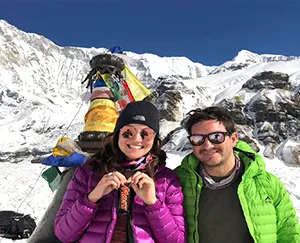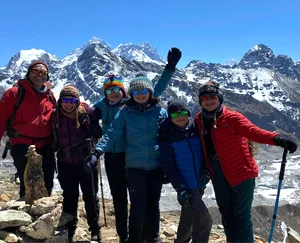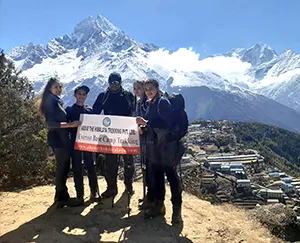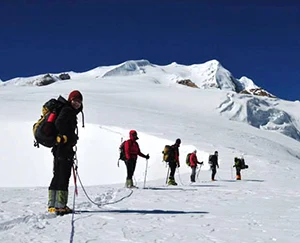The Everest view jeep tour is easy in terms of physical challenge. Almost the entire journey is by 4×4 vehicles on famous roads, so you do not need to be a seasoned trekker. There are two short hikes: a sunrise walk 1–2 hrs round-trip, and an optional village walk 1–2 hrs. These hikes are gentle and optional. Because you drive to elevations around 2,900 meters, the slopes are gradual and the pace is relaxed.
Most travelers find this trip very comfortable. You spend nights in good guesthouses or lodges with warm rooms, hot showers, and home-style meals. This tour can be enjoyed by even non-hikers and families with kids. The challenge is time spent inside the jeep instead of the steep climbing. The road may be zigzag and rough in places, but our drivers negotiate it with safety. Technical equipment and ropes are not required.
In summary, the Everest view jeep tour is easy-going. All you require is simple fitness and no issue with short walks and you could enjoy each moment. Everest and the Himalaya can easily be viewed without much effort trekking. It is a slow-paced tour, with numerous rest stops, and therefore any reasonable tourist can attend. You are able to relax and enjoy the scenery without having to worry about physical strain.
Acclimatization & Altitude Strategy
This trip has a moderate highest altitude of approximately 2,932 meters (Dhap Bazaar). Majority of them are at ease with this height. Instead, You gain altitude gradually by road (1,400 m – 2,900 m). Hydrate, rest well, and keep warm at dawn. Consume plenty of water, take light food and sleep well so as to prevent any altitude effects.
In the mornings at 2 900 m, it can be cold, and it is better to dress warmly during the dawn rises. In case of mild effects (headache, dizziness), rest at the viewpoint until you feel well. Our guide will observe all of us regarding symptoms. We have simple first aid and are able to slow down. Others also bring altitude medicine such as acetazolamide in case but is not necessary on this easy journey.
Overall, altitude is not a serious issue on the Everest View Jeep Tour. We do not stay long in high places, and we do not hurry or work too hard. The risk is low compared to longer high-altitude treks.
By following the strategy of steady ascent, hydration and rest, you can enjoy all the Himalayan views without worry. Most guests remember the clear air and spectacular vistas, not any discomfort. Avoid alcohol and smoking, especially before the hike, to help your body adapt. Focus on light exercise and deep breathing on the trail to feel your best.
Accommodation and Meals
You will stay two nights in comfortable mountain lodges or guesthouses during this tour. On the first night in Dhap (also called Dhap Bazaar), the lodge offers twin-share rooms with clean bedding and heating. A second night at the hilltop village offers similar cozy rooms and amazing mountain views through the windows. blankets provided; electricity is typical; hot showers and room heating where available (often a small extra fee). In short, no camping is needed, just simple hotel comfort at a high elevation.
All meals on the jeep tour are included as per the itinerary. You get three meals each day (breakfast, lunch and dinner on days 1 and 2; breakfast and lunch on day 3). Your guide arranges home-style Nepali meals for the group. Typical dishes include steamed rice, lentil soup (dal), mixed vegetables, curry, and occasionally meat or eggs. One of the attractions is the local dal bhat platter, a filling rice, lentils and side dishes meal, which gives you full of energy. The mountain lodges usually have buffet dinners and local delicacies.
Vegetarian, vegan or gluten-free diets can usually be accommodated with advance notice. Bottled drinking water is available along the route, so you can refill your bottles during stops. Feel free to bring your favorite snacks, but most needs are covered. Overall, you will dine on tasty, nutritious food that fuels your adventure in the Himalayas.
Altitude Sickness
Because the Everest View Jeep Tour only reaches about 2,900 meters and includes a gradual ascent, serious altitude sickness is unlikely. However, we still caution travelers to watch for mild symptoms. On waking day 2 and 3, drink extra water and take the hikes at your own pace. Common symptoms at this height include a headache or slight breathlessness, but they usually go away after a short rest.
The best prevention is to ascend slowly and stay hydrated. Avoid alcohol or caffeine before sleeping at high altitude. Move slowly on the morning hikes, and breathe deeply. If you experience any discomfort like a headache or fatigue, let the guide know. Most travelers feel fine and do not need any medicine.
In summary, altitude sickness is rare on this trip. By following a relaxed schedule and listening to your body, you can handle the modest altitude with ease. Always report any symptoms immediately; our team knows how to respond quickly. With the right precautions, you will enjoy the Everest views without problems. If you plan to use altitude medication (such as Diamox), take it as advised by a doctor before travel. Also, dressing in layers helps you stay warm and combat any minor symptoms.
Best Time to Do This Trip
The best time best time to do this trip is in the dry seasons of Autumn (September to November) and Spring (March to May). During these months, the skies are usually clear and the mountain views are spectacular. Autumn brings stable weather and colorful festivals in Nepal, while spring offers moderate temperatures and blooming rhododendrons. Mount Everest and the Himalayan peaks are most visible in these seasons.
You can also travel in December to February (Winter). The weather is colder with possible light snow, but since our route stays below 3,000m, it is still comfortable. A clear winter morning can offer very crisp views of Everest under a deep blue sky.
The monsoon season (June to August) is not recommended. Heavy rains can block the mountain views and make the unpaved roads muddy. If you travel in June-August, expect cloudy skies and delays. During monsoon, landslides and temporary road closures are possible, so travel delays may occur.
Each year, popular dates include mid-October and November when the weather is prime, so plan ahead and book early. In December, nights are cold but days warm up enough for the journey. In short, plan your Everest view jeep tour between March and May or September and November for the best chance of blue skies.
Health and Travel Insurance
Good travel insurance is mandatory for this adventure. Make sure your policy covers emergency evacuation and helicopter rescue. Our package includes arrangements for helicopter rescue (paid by your insurance), but you must have a valid travel insurance plan to cover any potential costs. Also, it’s wise to have standard health insurance that is valid internationally, in case of illness or injury.
Before the tour, check that you are up-to-date on routine vaccinations (tetanus, hepatitis A, diphtheria, etc.). On this trip, the health risks are minimal, yet we suggest the inclusion of a simple first-aid kit and any personal medication (painkillers, altitude pills, diarrhea medicine, sunscreen and insect repellant). To prevent frequent stomach complications, drink boiled or bottled water.
To be on the safer side, make copies of your insurance documents either by photocopy or electronic copy in case of emergency. Keep in mind that the facilities of Himalayan hospitals are limited and air evacuation coverage is essential. When you have good health and travel insurance, you can enjoy the views and the adventure without any worry.
Fitness and Preparation
You do not need special training or a high level of fitness for this Everest view jeep tour. Riding in a jeep is the primary activity, and there are only two brief hikes (around 2-5 km each) with low elevation. But, it is beneficial to be in good shape. Prior to the trip, attempt to perform some light exercises or walking to maintain a healthy activity. If possible, go on a couple of weekend hikes or long walks to prepare your legs for the sunrise hill climbs. Good balance can help on the uneven village trails. Because the tour involves 7–9 hours of driving on mountain roads, some people experience fatigue from sitting. If you tend to get stiff, practice stretching exercises or short walks at home to build stamina.
Consistent exercise such as jogging or biking can enhance endurance. In case you have some problems with your back or neck, you can bring supportive pillows. All in all, this tour is easy and fun as long as you are reasonably healthy, and you like to do light activity.
Guide and Staff
A professional local guide and an experienced driver will guide you in your tour. The guide is a fluent English speaker (and in many other languages) who knows the Everest area very well. All the logistics and cultural knowledge is in their hands and you only have to enjoy. The driver is an expert on mountain roads and he will make your ride easy in the tarmac and in the rough roads. These two employees are friendly, patient and safety-oriented.
The team size varies. Individuals or small groups have exclusivity to a jeep with one driver and guide. In larger groups, you are accompanied by several jeeps and guides, which makes the ratio personalized. Each of the guides is certified by the Nepal Tourism Board and trained in first-aid. Guides carry communication equipment (phones/radios) in the event of assistance, and navigational aids (maps, altimeter, GPS). You can trust that our Everest view jeep tour crew will do their best to make this journey comfortable and safe for you.
Is This Trip Beginner-Friendly?
Yes, this Everest view by jeep tour is very beginner-friendly. We designed this trip for people with little or no hiking experience. Since you spend most of the time in a jeep, you do not need to know how to trek. The two short hikes are easy trails with minimal incline. They can be skipped or shortened if someone feels tired.
Families with children (age 8+) often enjoy this trip. Even active seniors can handle it with proper precautions. Everyone moves at a relaxed pace with frequent stops. The comfortable lodging and included meals take away any logistical worries.
Travelers who worry about high altitude should note that this tour never goes above 3,000 meters. No technical equipment or training is needed. If you are comfortable riding in a car and walking a little, this trip is a perfect introduction to the mountains. For many first-time mountain travelers, this Everest view jeep tour is very manageable.
Gadgets, Charging and Internet
Electricity and internet are available, but with some limits due to rural locations. The lodges have power outlets (typically 220V) so you can charge cameras and phones each evening. Carry a travel adapter, where necessary. As a backup, we suggest having a power bank, as electricity is not always available in remote locations. Some lodges can be equipped with generators or solar just to have some light.
Mobile phone connections are patchy along this route. In towns such as Sindhuli or Dhulikhel, there are 3G/4G signals however, you might lose signal in remote areas. Wi-Fi cannot be assured on the Jeep Tour, therefore, be prepared to be out of touch occasionally. The majority of the travelers spend the evening in the lodge to charge gadgets and post pictures. Mobile coverage is patchy; Wi-Fi is not guaranteed. Assume limited connectivity. Download maps or music beforehand. With a bit of planning, you can capture and share your Everest view jeep tour experience even with minimal signals.
Visa and Permit
All international travelers to Nepal need a visa. A tourist visa is available upon entry at Kathmandu Tribhuvan Airport or a land border. The fee is about USD 30 for 15 days (USD 50 for 30 days, Fees are subject to change so check the latest official rates before travel). Make sure to have a passport sized photo and sufficient cash. Citizens of India, Bangladesh and a few other countries have special arrangements (often free entry), but be sure to check Nepal’s rules for your nationality.
For the Everest View Jeep Tour, No national park or restricted-area permits are required as long as we stay outside Sagarmatha National Park. Local road or municipality fees (if any) are included. You only need to have your passport and Nepal visa with you everywhere. Keep a copy of your visa and passport ID page during the trip, as police may check at checkpoints.
Your Extra Expenses
You should budget for personal and optional expenses. These often include: international flights to Nepal and Kathmandu airport transfers; the Nepal visa fee (cash); travel and rescue insurance; alcoholic drinks and extra snacks; laundry and hot showers (some lodges charge a small fee); internet or SIM cards; tips for guide/driver; souvenirs or extra snacks; and any hotel nights in Kathmandu before/after the tour.
It’s wise to carry extra cash (USD or NPR) for these items. ATM access is limited outside Kathmandu. Common practices: Tipping guides about $5–10 USD per day and drivers $2–5 per day. Hot shower charges are a few dollars, and SIM cards or data packs a minimal price. With these extras in mind, you can have an enjoyable trip without unexpected surprises.
The Photography Hotspots and Best Views
The Everest view jeep tour offers many stunning photo opportunities. The best part is the sunrise perspective at Dhap Bazaar. From this hilltop, you get a broad panorama of the Himalaya. On a clear day you can photograph Everest and nearby ranges (broader 8,000 m panoramas when conditions are exceptional). The golden sunlight at dawn makes every peak glow.
You are able to take photos of prayer flags fluttering on the mountains during the morning hike. The Sherpa and Gurung villages add cultural interest: villagers in traditional dress, stone monasteries (chortens) and terraced fields make great subjects.
The journey itself is scenic. You’ll see the Sunkoshi River valley, remote forests and farmland. The mountainous curvy roads and the varying light provide numerous photo opportunities. Bring a good zoom lens for distant peaks and a camera for village life. With so many peaks and landscapes, every moment on this Everest view jeep tour is a picture-perfect memory.
![]() General
General![]() Preparation & Fitness
Preparation & Fitness![]() Permits
Permits![]() Insurance and Visa
Insurance and Visa![]() Guides & Support Staff
Guides & Support Staff![]() Accommodation and Facilities
Accommodation and Facilities![]() Food and Drinks
Food and Drinks![]() Weather & Seasons
Weather & Seasons![]() Health & Safety
Health & Safety![]() Packing & Gear
Packing & Gear![]() Booking & Payment
Booking & Payment![]() Transportation & Flight
Transportation & Flight Enjoy Himalayan scenery with the help of Nepal’s best guides with Government license holders and got training in first-aid, our Trip Leaders, know where you’ll find the best photos, most fascinating wildlife, and the best stream crossings.
Enjoy Himalayan scenery with the help of Nepal’s best guides with Government license holders and got training in first-aid, our Trip Leaders, know where you’ll find the best photos, most fascinating wildlife, and the best stream crossings.
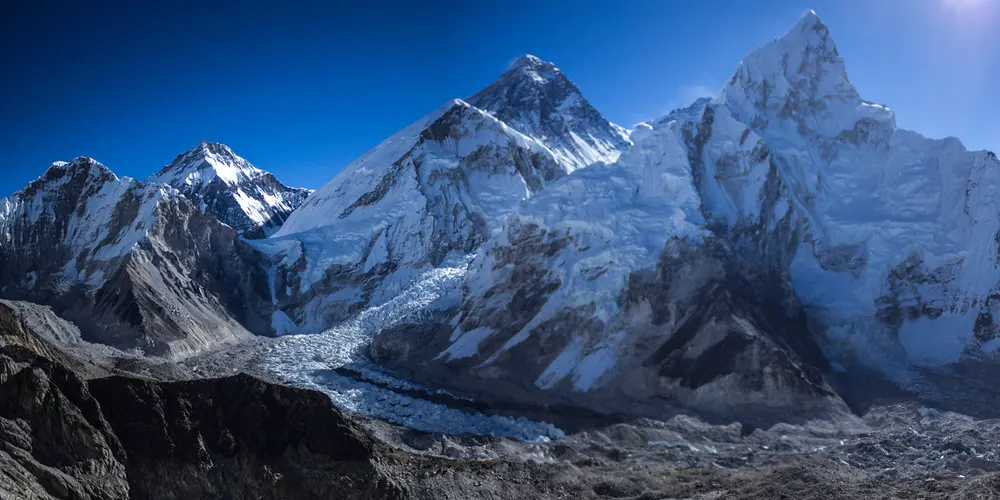




 Have Questions?
Have Questions?